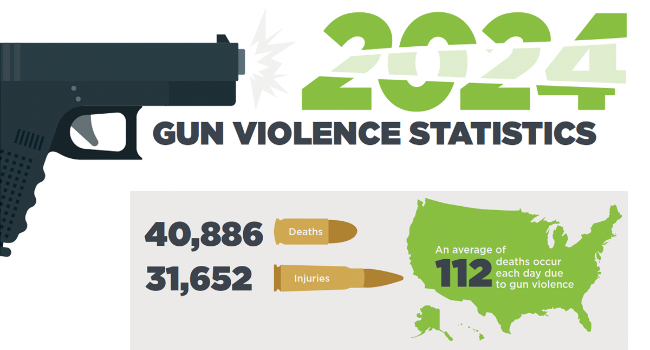
2024 Gun Violence Report Fewer Overall Incidents but School Deaths and Injuries Are on the Rise
Omnilert, provider of gun detection technology, today released its compilation of Gun Violence Statistics for 2024 summarizing gun violence tragedies and their adverse effects on Americans and the economy. While research showed a decrease in overall deaths and injuries, the rising number of school shootings and fatalities and high number of mass shootings underscored the need to keep more people safe in schools as well as places of worship, healthcare, government, retail and commerce, finance and banking, hospitality and other public places.
The full details and 2024 gun violence statistics are available now. Key results include both encouraging and alarming trends:
- Gun violence resulted in 40,886 deaths and 31,652 injuries, a 9 percent decrease from 2023. More than 5,200 of those were children and teens.
- Mass shootings decreased 24 percent from 659 in 2023 to 503 this past year.
- The number of school shootings in each of the last 4 years is more than 107 percent higher than any year prior to that for the last 25 years. In 2024, there were 330 incidents in schools.
- The number killed and wounded by guns on K-12 school property increased 7 percent to 267 people, compared to 249 in 2023.
“The fact that there was an overall decrease in deaths and injuries is absolutely a step in the right direction, but the increased numbers in our schools and an average of 112 deaths in the U.S. each day due to gun violence is not acceptable,” said Dave Fraser, CEO of Omnilert. “Every fatality is one too many and with solutions now available to help prevent these tragedies, it is possible to start reversing all the trends if we work together and take a layered approach to mitigating gun violence.”
Hidden Costs of Gun Violence in America
he annual summary also highlighted the growing cost of gun violence to Americans across the country. This represents more than $557 billion annually, which is roughly $1700 per American citizen that could be allocated elsewhere. Two examples include:
- Losses in revenue and productivity due to firearm injuries is estimated to cost private employers $535 million per year nationwide. Research has shown that one non-fatal firearm injury leads to roughly $30,000 in direct health care spending per survivor in the first year alone.
- A city like Columbus, Ohio incurs $500 million in expenses per year due to gun violence. A single homicide consumes $2.1 million in tax-paid resources while one non-fatal shooting costs $738,000.
A Layered Approach to Better Protection
As the report called out, no single technology or strategy is effective by itself to curb gun violence. Instead, a layered approach is needed with different solutions working together. This includes technologies such as AI visual gun detection, security personnel and school resource officers, better training and planning, and access controls and perimeter fences, to name a few.